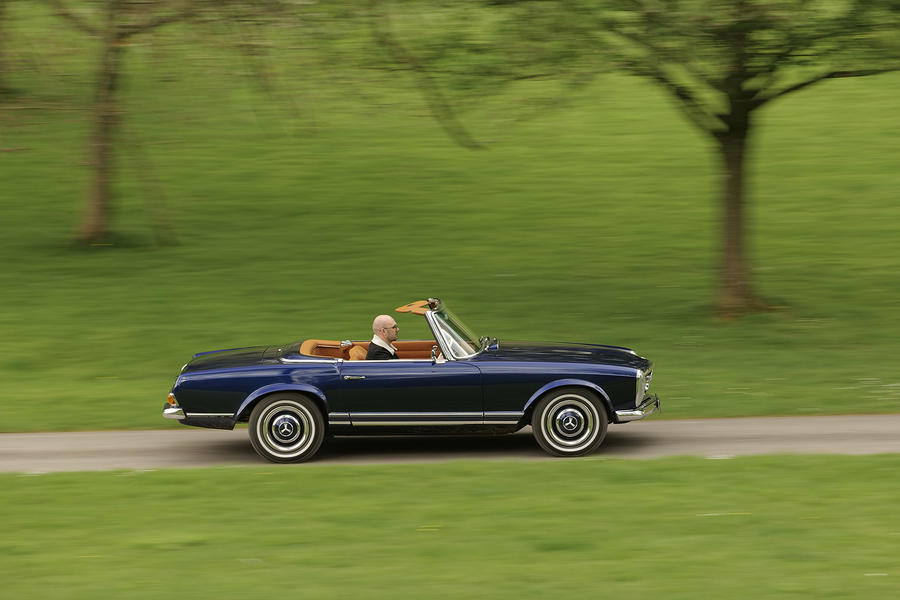Prices start from £396,000 (plus a donor car)
Everrati’s electric luxo-mod business is picking up pace. Is a Pagoda with twice the original power sacrilege?
Who spends almost half a million pounds on an electrified restomod? According to Everrati, it’s a very eclectic bunch.
Many of its customers are in the US; around one-third of them are female; and some don’t yet have a driving licence but are instead the fortunate beneficiaries of petrolhead parents foreseeing a zero-emissions future and ordering an EV classic to ensure their offspring will have something truly special to drive.
Perhaps what’s even more striking is that some buyers are already on their second or third Everrati.
The Oxfordshire-based electric car specialist has grown impressively since I last drove one of its cars, the Porsche 964-based ‘Signature’, almost three years ago.
The model range now encompasses various Land Rovers, a Ford GT40 tribute and this 1960s Mercedes-Benz SL, which, alongside a new ‘Engineering by Everrati’ consultancy division, ensures its workforce has swelled.
Founder and CEO Justin Lunny smiles as he lists the previous companies on his employees’ collective CV: McLaren, Bentley, Rimac and Singer are the most impressive. “People are coming to us, we don’t have to go looking for them,” he says.

While the 911s and GT40s that came before the SL are capable of whipping websites’ comments sections and social media platforms into frenzies, perhaps this W113-generation SL ‘Pagoda’ is a safer bet: it’s a car that hasn’t traditionally traded on high revs and a sonorous soundtrack as part of the experience.
It also helps prove the concept of a front-engined, rear-wheel-drive car with the Everrati powertrain formula; Lunny hints at much more to come from the set-up that is shoehorned into the Pagoda’s compact transmission tunnel. Astons, Jags, Rolls-Royces… The possibilities are enormous.
Bring Everrati a donor car – it can be a 230, 250 or 280SL – and its straight-six engine and gearbox are removed and replaced by an electric motor (made by Helix, whose tech powers the Lotus Evija) and a choice of two batteries: you can have 54kWh or 68kWh for a 160-or 200-mile range respectively.
You will get roughly twice the power, at 300bhp, while torque climbs more modestly to 221lb ft, but it’s enough for 0-62mph in less than 7.0sec if you go for the bigger battery.
There’s KW suspension to handle the extra mass (unspecified, but “well within” the Pagoda’s 1.7-tonne gross figure) with weight distribution closely mimicking that of its donor.
A limited-slip differential, regenerative braking and new hydraulic power steering help modernise the driving experience but without losing the SL’s charm. The tunability of those KWs means each customer can make their car as comfy or committed as they like, while a bunch of drive modes allow on-the-fly adjustments to the car’s character.

Standard air-con and swanky Bridge of Weir leather help further justify the £330,000 you’ll spend before taxes – but that’s after you’ve paid out for your donor car.
My drive is limited to the confines of a private estate, so sprints beyond 20mph are brief, but the car builds speed smoothly and briskly without being uncouth. This is a relatively skinny car in the EV world, and clearly Everrati’s engineers could tune an electric motor to hustle it forwards with more shocking haste. But the fact they haven’t, instead delivering broadly similar performance to a ’60s 280SL, shows how mindful their work is.
Likewise the steering tune, which is languid and allows the enormous, delicately rimmed wheel to float around off-centre without upsetting your progress. This is a car designed with a cosseting cruise up the coast in mind, the subtle whooshes and whines of the tyres and motor below underlining the feeling of calm.
Everrati’s first big project, its 911 Signature, came with an optional sound generator long before Abarth was causing a ruckus with such things. Lunny confirms only one person has so far optioned it, and he adds that as yet he has no interest in offering a manual gearbox like some rival electromodders. “Most people don’t want to keep their car’s original engine, even,” he says. “They aren’t interested in its past, they only want to see its future.”
His guarantee of completely reversible engine swaps has yet to be exploited. “We don’t expect people to do it,” he admits.
“In the UK, we work on a points system to avoid the Q-plate of a ‘radically altered vehicle’. Our cars are rolling art in many cases, and the principle of reversibility is more so we don’t damage the structure of the vehicle. It’s the same principle as a Grade I or II listed property: you might upgrade the heating or kitchen, but you’ll keep the structure pristine.”
Source: Autocar
